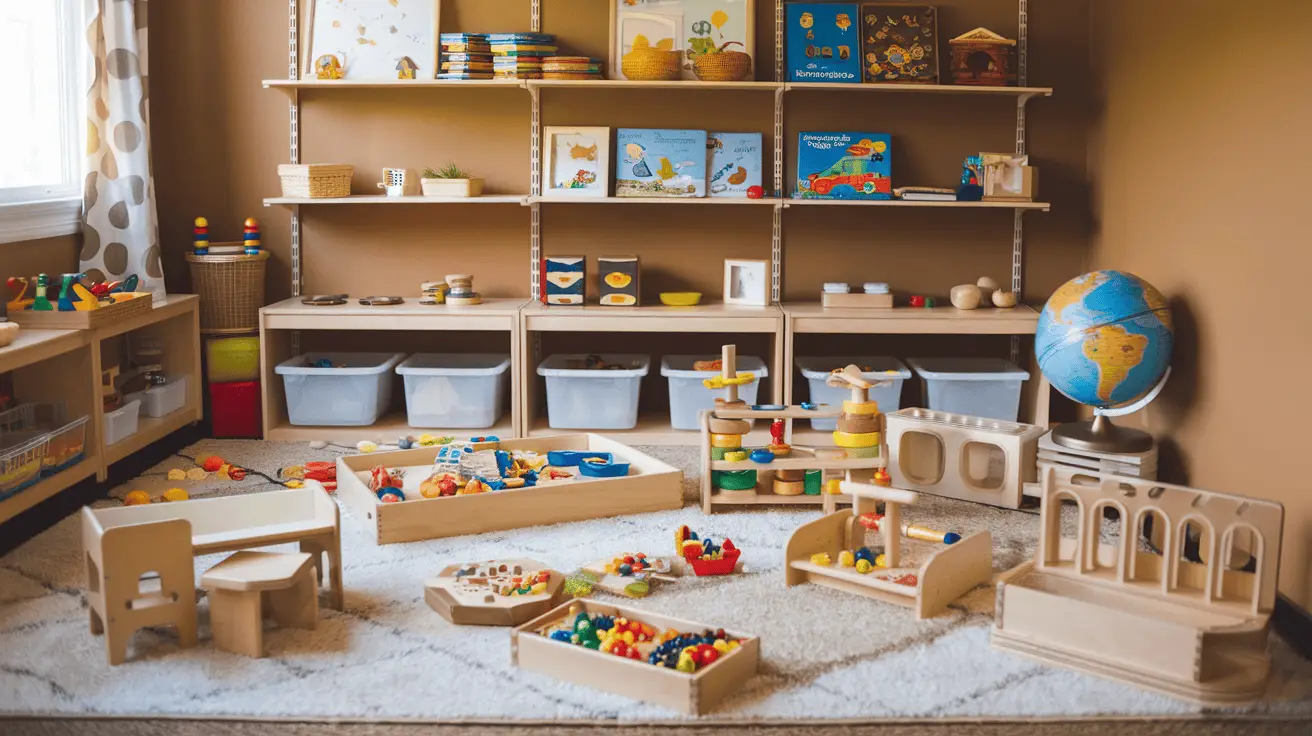
Introduction: Why a Montessori Playroom Works for Small Spaces
Every parent has experienced the struggle of keeping a playroom organized. Toys pile up, clutter seems to multiply overnight, and somehow, even in a small space, chaos takes over. But what if there was a way to create a calm, structured, and engaging environment that encouraged children to explore, learn, and play independently—without the mess and overstimulation?
That’s exactly what a Montessori-inspired playroom offers. This design approach isn’t about filling a space with endless toys, bright colors, and plastic furniture. Instead, Montessori spaces prioritize simplicity, order, and hands-on learning, allowing children to develop independence, creativity, and focus.
A small playroom can be the perfect setting for a Montessori-style setup, as it encourages intentionality with toy choices, organization, and layout. Every object in the room serves a purpose, and less truly becomes more. With thoughtful design choices, a tiny playroom can become a world of exploration, learning, and fun—without ever feeling cluttered or overwhelming.
This guide will take you through five essential steps to transform a small playroom into a Montessori-inspired learning space, focusing on color choices, organization, furniture, and play-based learning.
1. Choosing the Right Colors for a Montessori Playroom
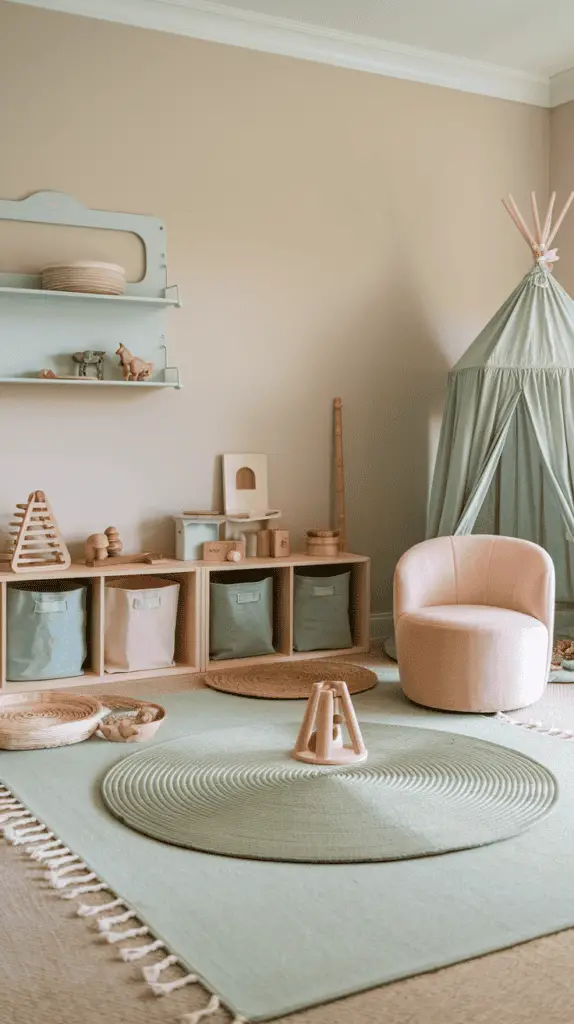
One of the first things to consider when designing a Montessori-inspired playroom is the color palette. Unlike traditional playrooms, which often feature bold primary colors and loud patterns, a Montessori space embraces soft, natural tones to create a calm and inviting atmosphere.
The Role of Color in a Montessori Space
Children absorb their surroundings in a way that adults don’t. Bright reds, electric blues, and high-contrast designs can sometimes lead to overstimulation and distraction. The Montessori approach encourages neutral and pastel colors that allow children to focus on their activities rather than the visual noise of the room.

For small playrooms, choosing lighter colors can also help create the illusion of space, making the room feel bigger and airier.
Best Montessori-Friendly Colors for Small Playrooms
• Soft white or warm beige for a clean, neutral base.
• Light sage green to introduce a calming, nature-inspired feel.
• Muted blues and grays for a sense of tranquility.
• Blush pink or pale peach to add a gentle warmth.
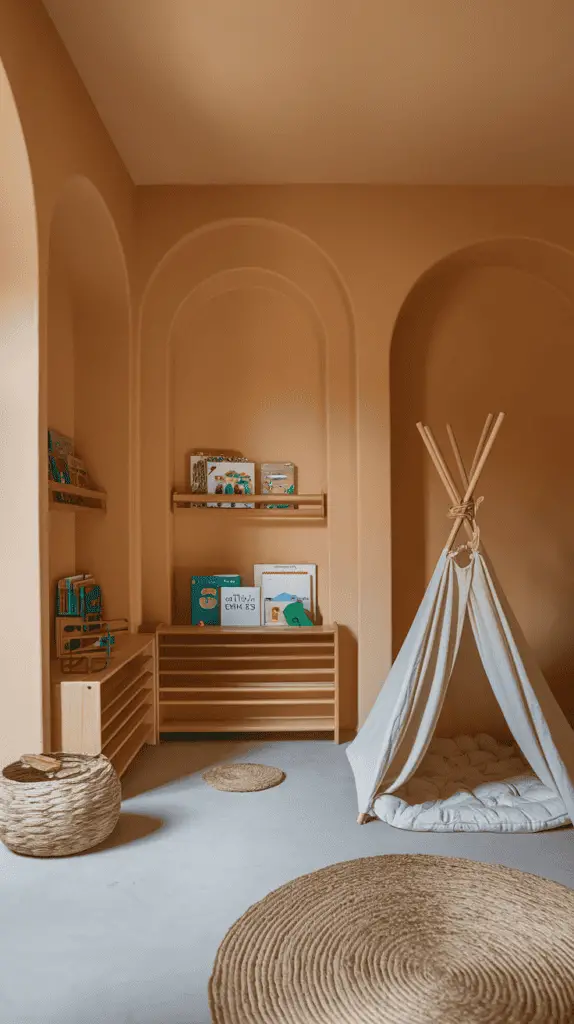
If you want to add a touch of color, you can do so through wooden toys, natural fiber rugs, pastel storage baskets, and fabric play tents rather than painting the walls in bright shades.
A neutral backdrop allows the materials, books, and toys to stand out, making them the focal point of the playroom rather than the walls or decorations.
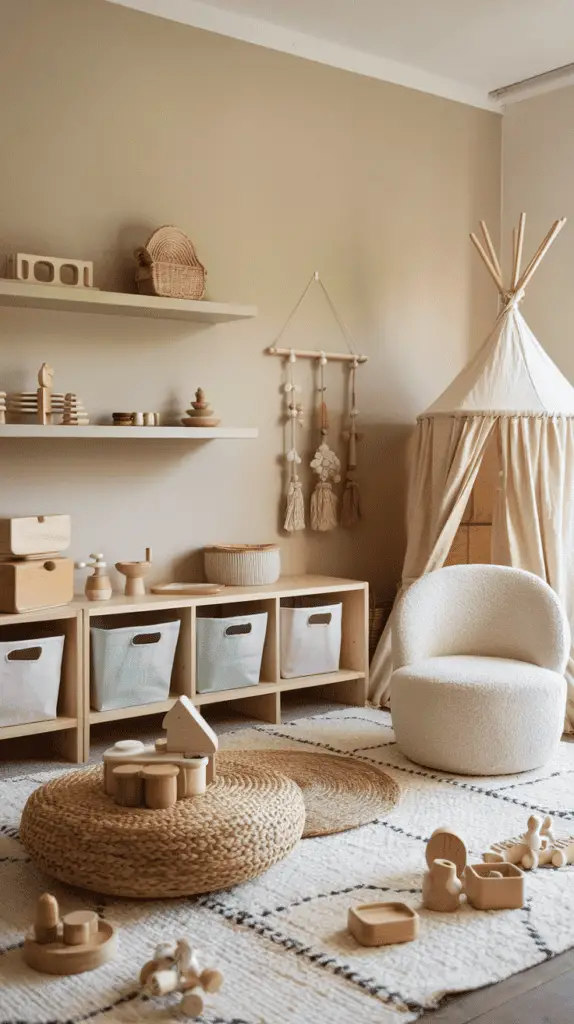
2. Setting Up Open Shelving for Accessibility & Organization

A core principle of Montessori playrooms is accessibility. Every item in the playroom should be easily reachable, allowing children to make their own choices, engage with their environment, and take responsibility for tidying up.
Why Open Shelving Works Best
Instead of storing toys in large, overflowing bins or cabinets, Montessori spaces use low, open shelves that allow children to see their options clearly and choose their activities with intention.
This approach benefits small playrooms by:
• Maximizing vertical space instead of cluttering the floor.
• Creating a visually organized environment with only a few toys displayed at a time.
• Encouraging independence by making it easy for children to take out and put away their activities.
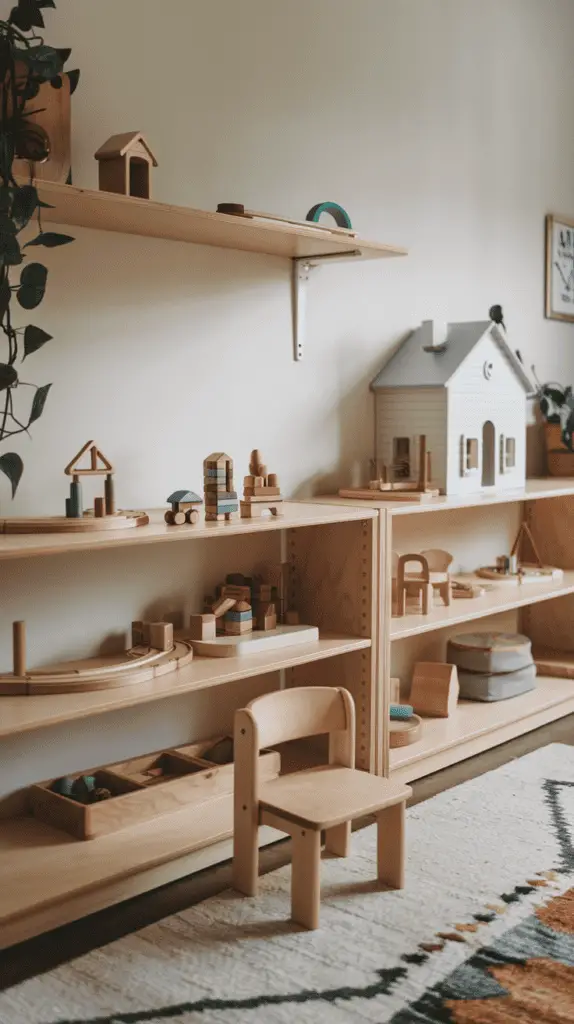
How to Organize Open Shelving in a Small Playroom
• Use low wooden shelves or cube storage units that are no taller than your child’s chest height.
• Keep only 6-10 toys or activities out at a time to prevent clutter.
• Store extra toys in a separate rotation bin, swapping them out every few weeks.
• Use woven baskets or small wooden trays to keep toys neatly grouped together.
This setup not only keeps the space tidy but also encourages deeper engagement with fewer distractions.
3. Creating a Cozy & Functional Reading Corner
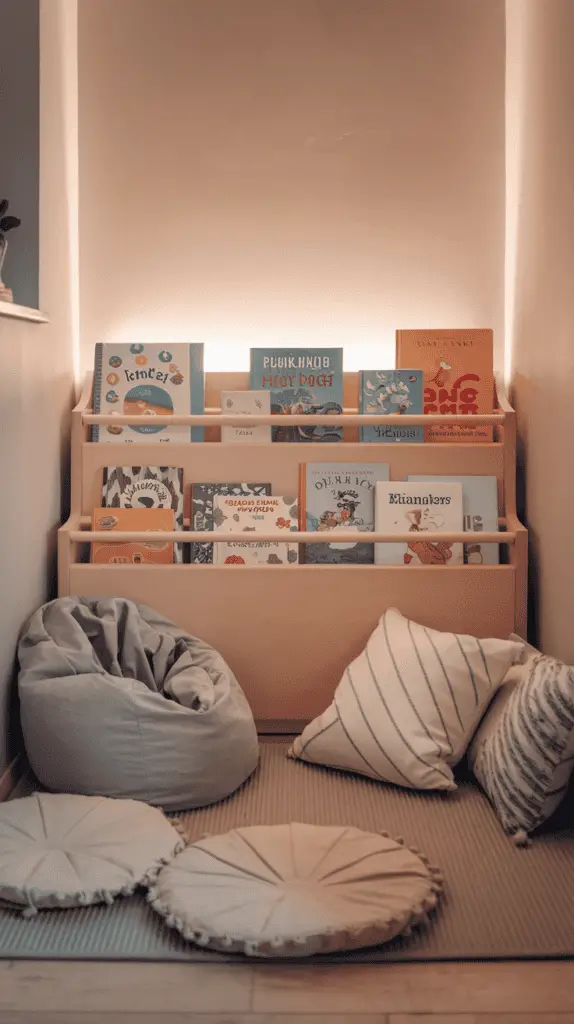
Reading is a fundamental part of Montessori learning, and every well-designed playroom should include a dedicated space for books and quiet time. Even in a small room, a cozy reading nook can encourage children to explore stories, develop their imagination, and build a love for reading.
How to Set Up a Reading Corner in a Small Playroom
• Choose a quiet corner or small section of the room away from high-traffic areas.
• Use a low, front-facing bookshelf that allows children to see and choose books easily.
• Add soft floor cushions, a small bean bag, or a cozy rug to create a comfortable sitting area.
• Keep only 10-15 books out at a time, rotating them every few weeks to keep interest fresh.
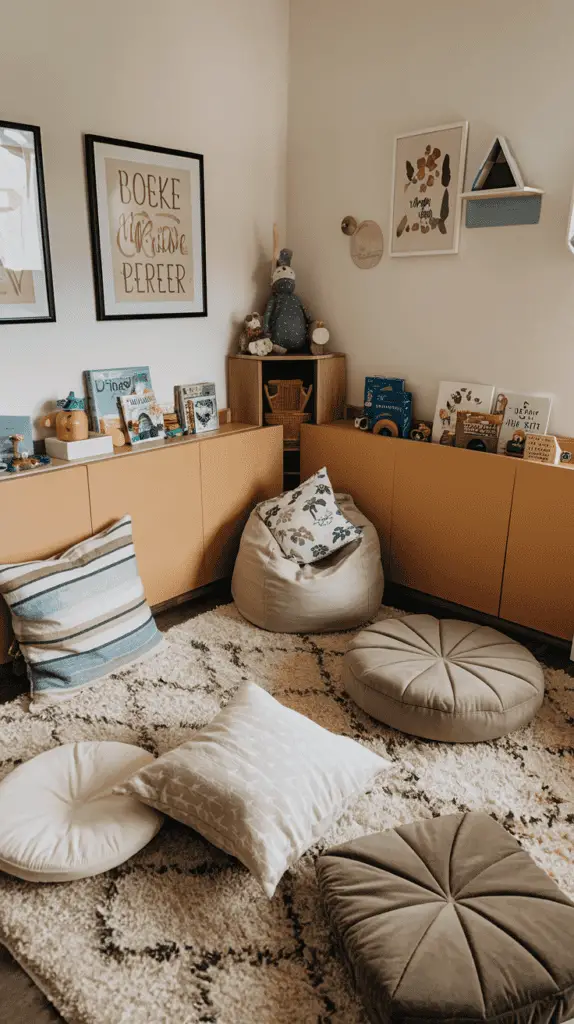
If space is very limited, you can create a wall-mounted reading nook by:
• Installing floating bookshelves at child height.
• Adding a foldable floor mat that can be stored when not in use.
• Using a pastel canopy or draped fabric to define the space.
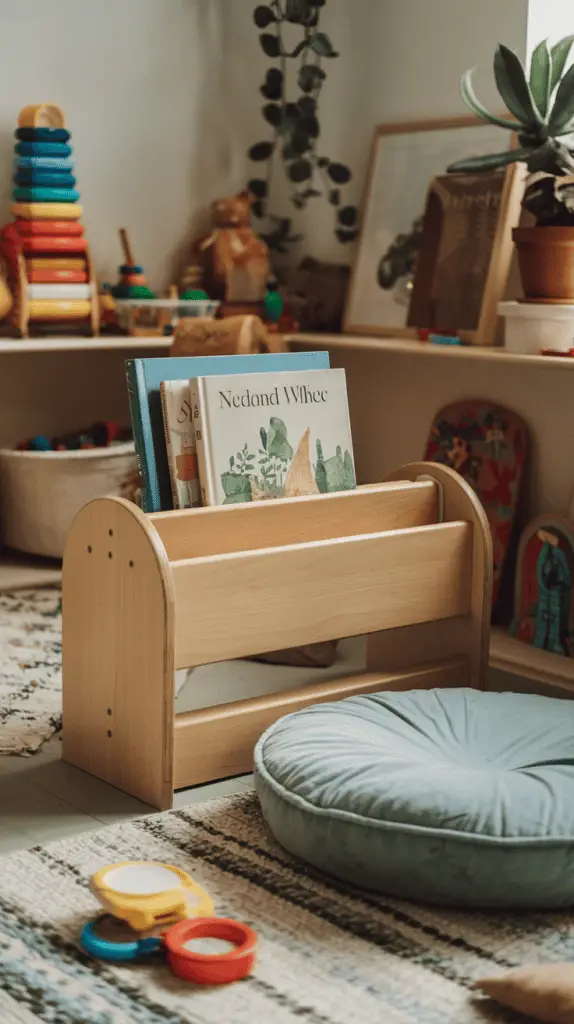
By keeping the reading area simple, clutter-free, and inviting, children will naturally gravitate toward it, making reading a daily habit.
4. Selecting Montessori-Friendly Toys That Encourage Learning
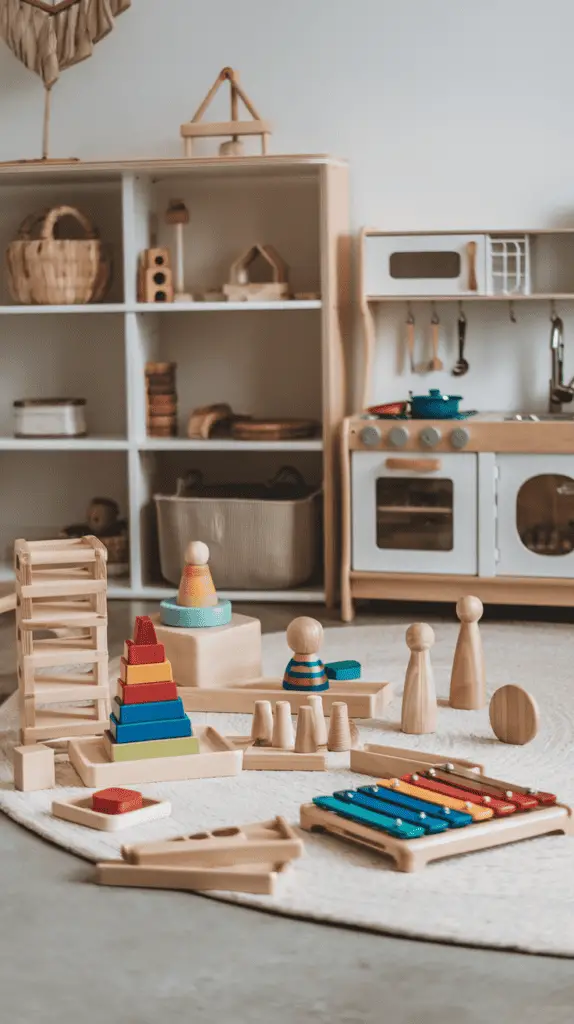
Montessori playrooms follow the philosophy of quality over quantity. Instead of plastic toys that light up, make noise, or dictate how a child should play, Montessori toys are designed to be open-ended, natural, and engaging.
The Best Montessori Toys for Small Spaces
• Wooden stacking blocks to develop motor skills and creativity.
• Shape sorters and puzzles to encourage problem-solving.
• Simple wooden dolls or animals for imaginative storytelling.
• Musical instruments like a xylophone or tambourine for sensory play.
• Practical life toys like small brooms, toy kitchens, or toolsets that encourage real-world skills.
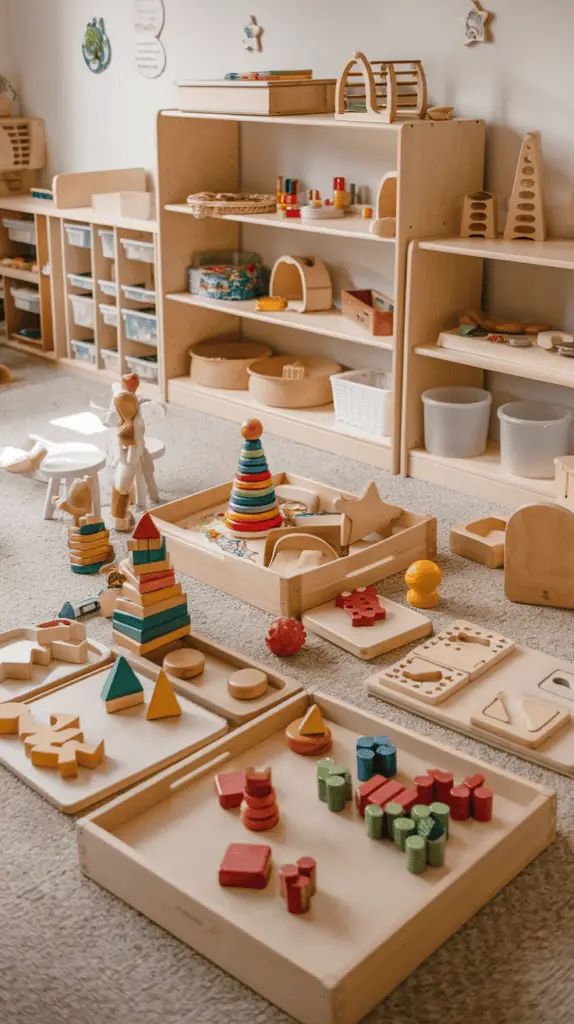
Because small playrooms don’t have space for unlimited toys, the best approach is toy rotation—keeping only a few well-chosen toys out at a time and swapping them every few weeks.
By offering a curated selection of engaging materials, children are less overwhelmed and more focused, leading to deeper and more meaningful play.
5. Using Multi-Purpose Storage to Keep the Room Clutter-Free
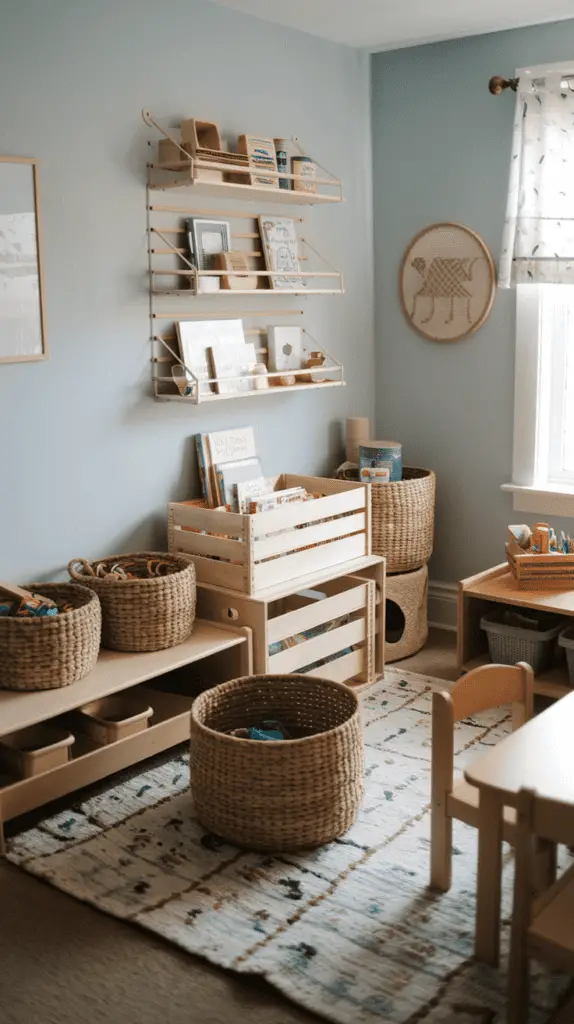
Storage is one of the biggest challenges in a small playroom, but Montessori design offers simple and effective solutions to keep everything organized, functional, and visually pleasing.
Best Storage Solutions for a Small Montessori Playroom
• Woven baskets and wooden bins keep toys accessible but neatly contained.
• Stackable wooden crates can be used for books, art supplies, or puzzles.
• Floating wall shelves maximize space while keeping the floor clear.
• Under-bench storage or ottomans with hidden compartments help keep extra materials out of sight.
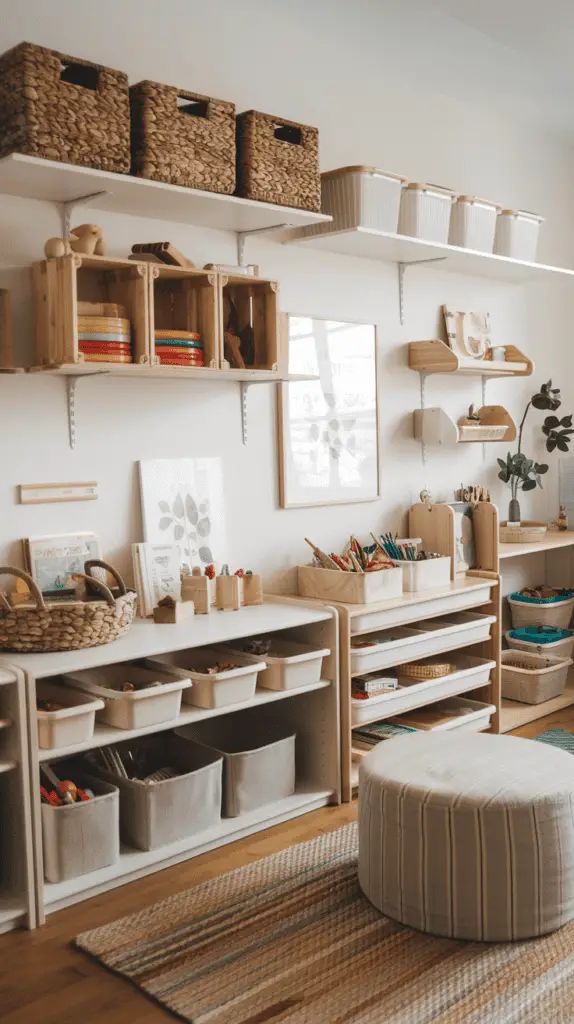
The goal of storage in a Montessori playroom isn’t to hide everything away, but to create an ordered space where everything has a designated place.
6. Designing a Practical Life Area for Everyday Skills
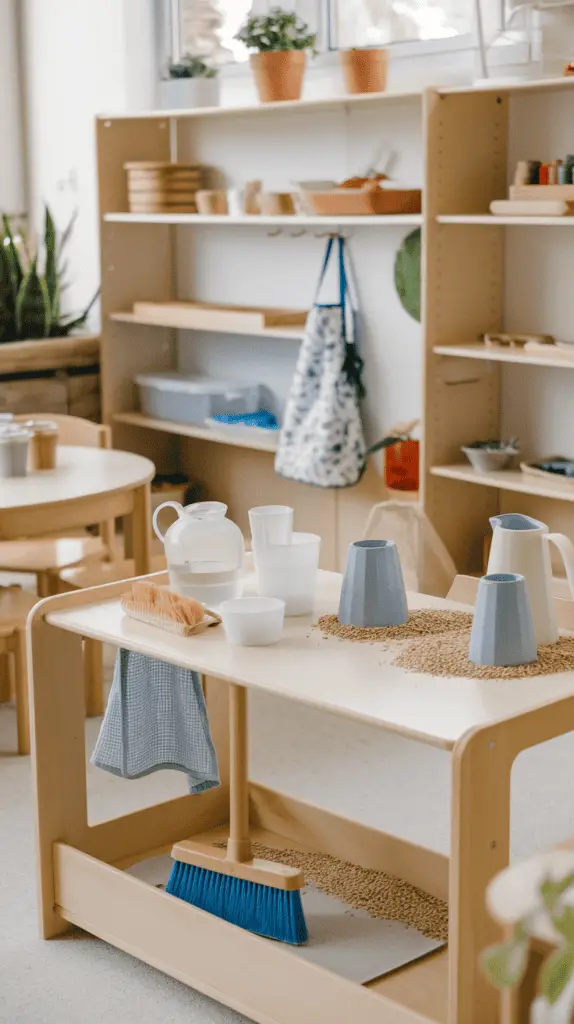
A Montessori playroom isn’t just about play—it’s about preparing children for real life by encouraging them to practice daily tasks that build fine motor skills, responsibility, and independence. Even in a small playroom, you can set up a practical life area where children can engage in hands-on activities that mimic real-world tasks.
How to Incorporate Practical Life Skills in a Small Playroom
• A child-sized cleaning station with a small broom, dustpan, and cloth so they can help tidy up.
• A pouring and scooping station using small pitchers, cups, and dry beans or rice for sensory play.
• A low-hanging hook for aprons so children can easily grab one before engaging in messy activities like art or cooking.
• A small snack area with a child-accessible water dispenser and cups so they can pour their own drinks.
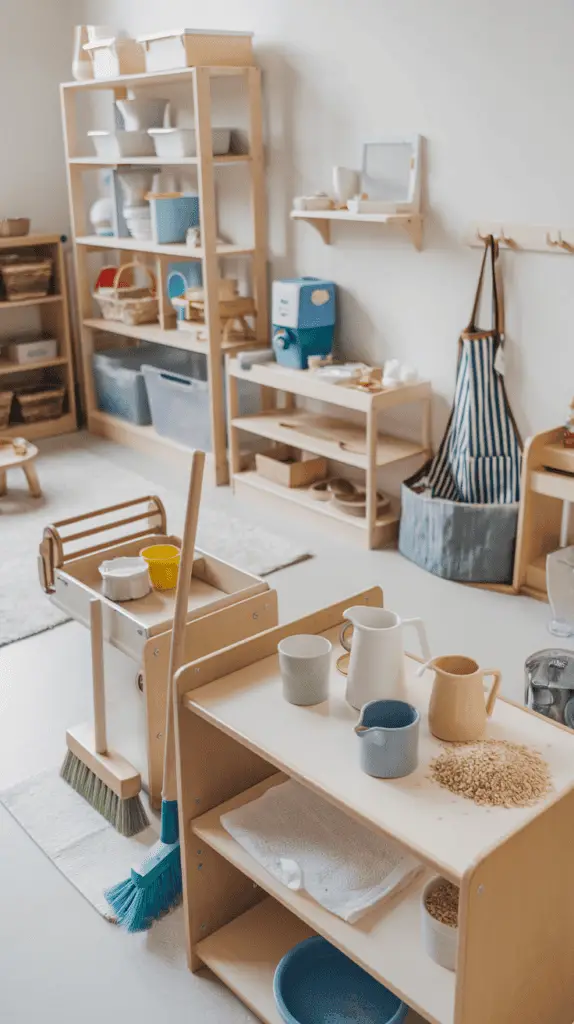
These activities may seem simple, but they help children build confidence and develop real-life skills, making them feel capable and independent from an early age.
7. Bringing Nature Into the Playroom for a Sensory Experience
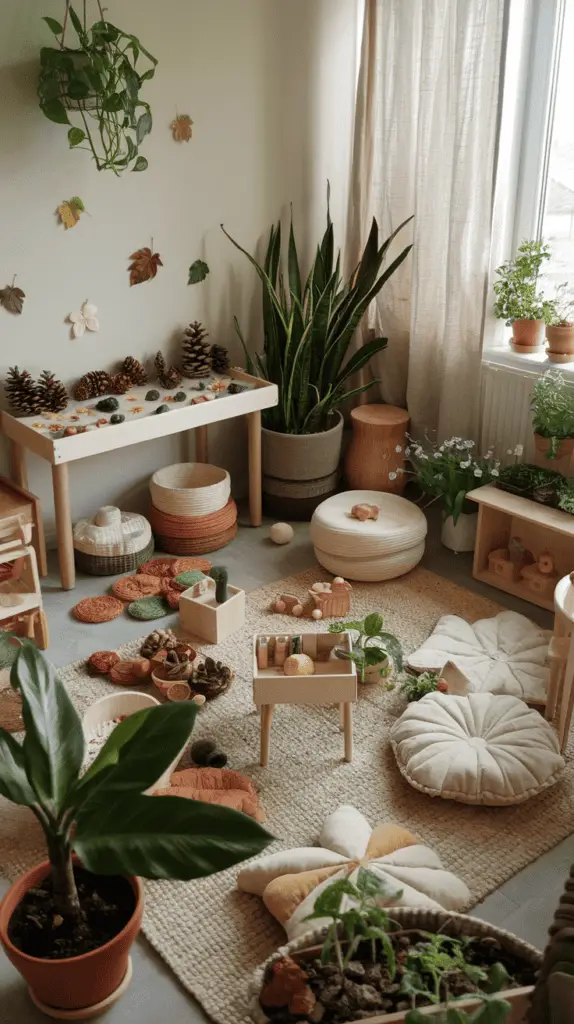
The Montessori method emphasizes a strong connection to nature, and even if you live in a city apartment with limited outdoor access, you can bring elements of the natural world into the playroom to create a calming and engaging sensory experience.
Ways to Introduce Nature to a Small Playroom
• Houseplants that children can water to encourage responsibility.
• A nature table where children can display pinecones, leaves, rocks, or flowers they collect from outside.
• Natural materials like wooden toys, wool rugs, cotton cushions, and linen curtains to create an organic, grounding environment.
• A small indoor herb garden where children can help plant and care for easy-to-grow herbs like basil or mint.
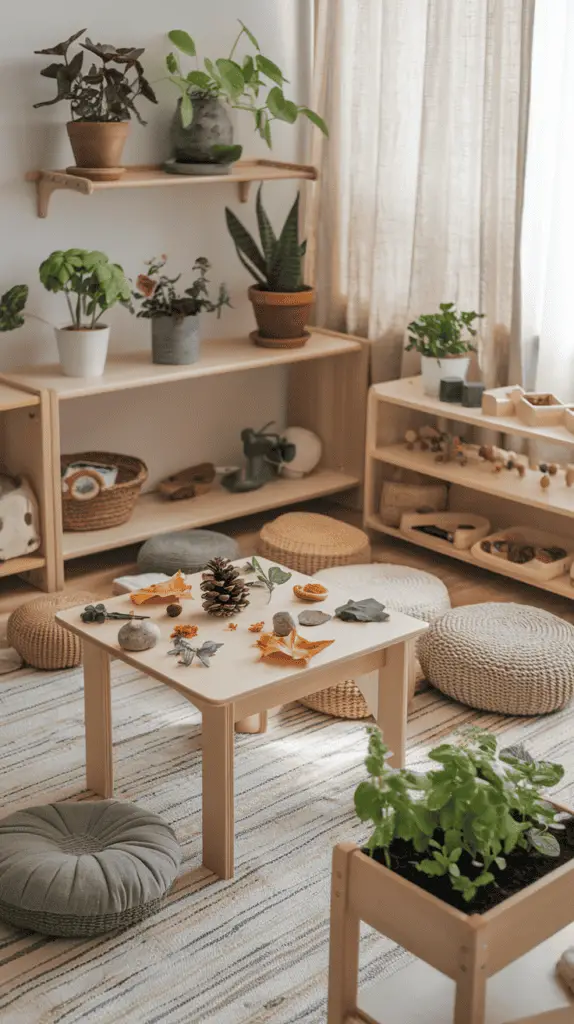
By surrounding children with natural textures, scents, and materials, you create an earthy and peaceful space that supports sensory development and emotional well-being.
8. Incorporating a Sensory Play Zone Without Overwhelming the Room
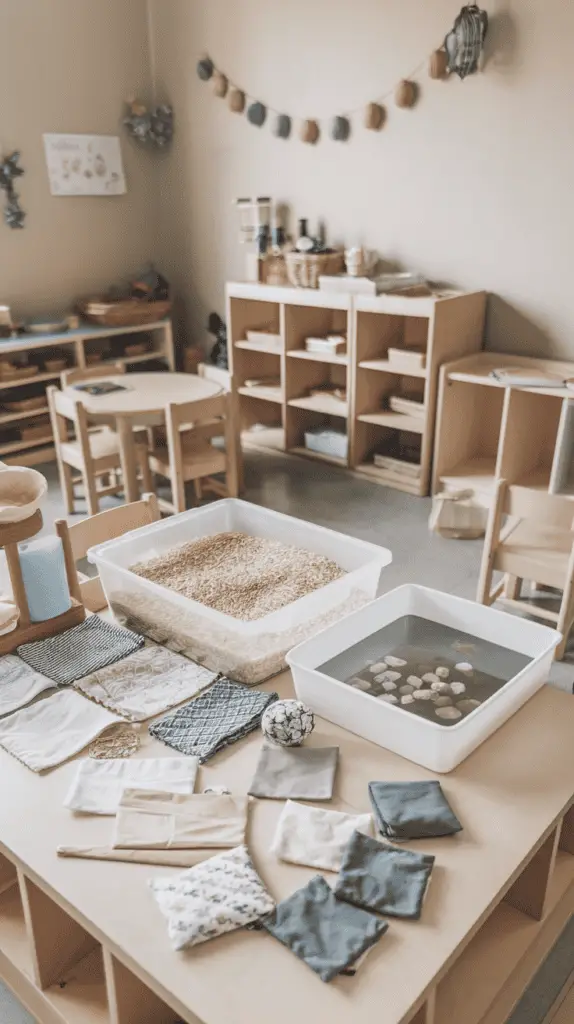
A sensory play area is an important part of early childhood learning, but in a small Montessori playroom, it needs to be carefully curated to avoid overstimulation. Instead of large, messy setups, opt for simple and structured sensory activities that can be easily stored when not in use.
Simple Sensory Play Ideas for Small Spaces
• A sensory bin filled with dry rice, sand, or pasta, with small scoops and cups.
• Fabric swatches with different textures to explore through touch.
• A small container of water with floating objects for scooping and pouring.
• A scented area with lavender sachets or cinnamon sticks to engage the sense of smell.
Instead of keeping everything out all the time, use storage baskets or lidded containers to keep sensory materials neatly stored and rotated based on your child’s current interests.
9. Flexible Furniture That Adapts to Growing Needs
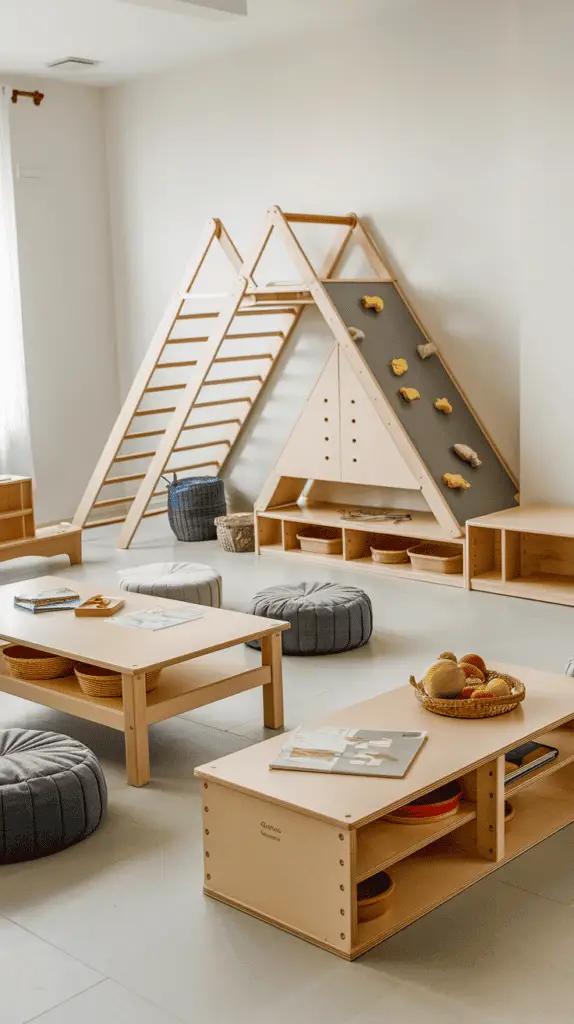
Since children outgrow furniture quickly, it’s important to choose pieces that can adapt over time. Instead of static, bulky furniture, opt for versatile and space-saving designs that allow you to reconfigure the playroom as your child grows.
Best Multi-Functional Furniture for Small Montessori Playrooms
• A low wooden table with storage underneath for activities, puzzles, and crafts.
• Floor cushions and poufs instead of fixed seating, so children can move them around freely.
• A child-sized bench with hidden storage to keep extra toys and books organized.
• A climbing triangle or balance board that can be used for physical play, flipped into a slide, or turned into a reading nook.
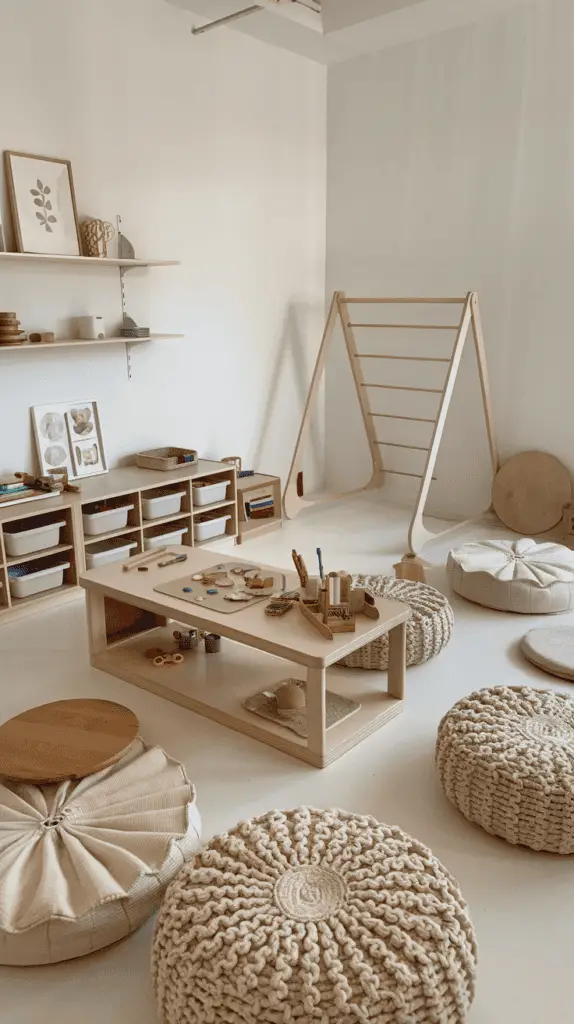
By choosing functional, minimalist furniture, you maximize play space while ensuring the room remains flexible and practical for years to come.
10. Keeping the Montessori Playroom Organized & Clutter-Free
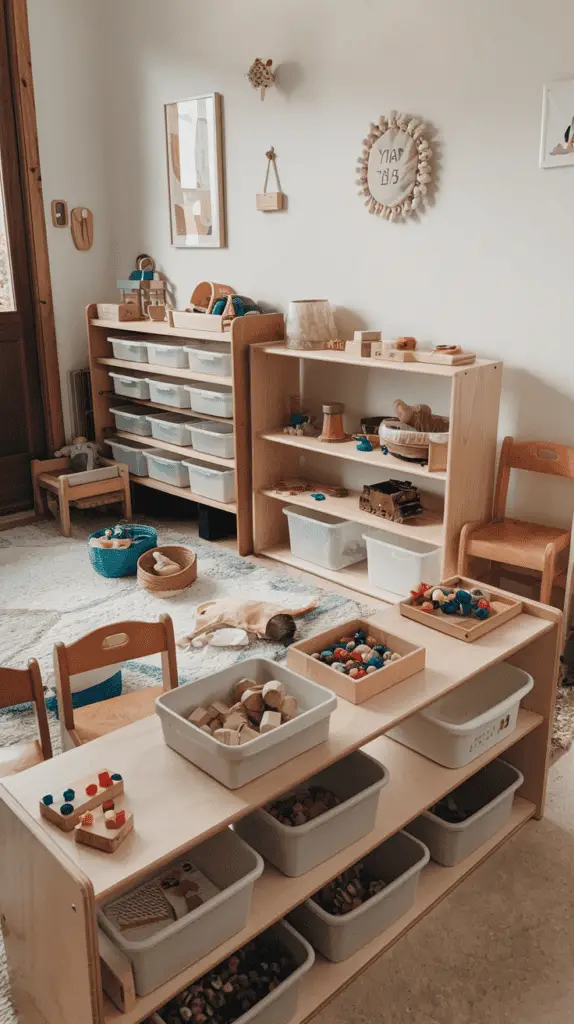
A cluttered playroom makes it harder for children to focus and engage meaningfully with their activities. Montessori playrooms follow the principle of “everything has a place,” ensuring that children learn to take care of their environment by putting things away after play.
How to Maintain Organization in a Small Montessori Playroom
• Limit the number of toys available at any time to avoid mess and overstimulation.
• Use labeled baskets and bins so children know exactly where to put things.
• Incorporate a “one toy at a time” rule, encouraging children to clean up before moving on to a new activity.
• Designate a clean-up routine at the end of each play session so that tidying up becomes a natural habit.
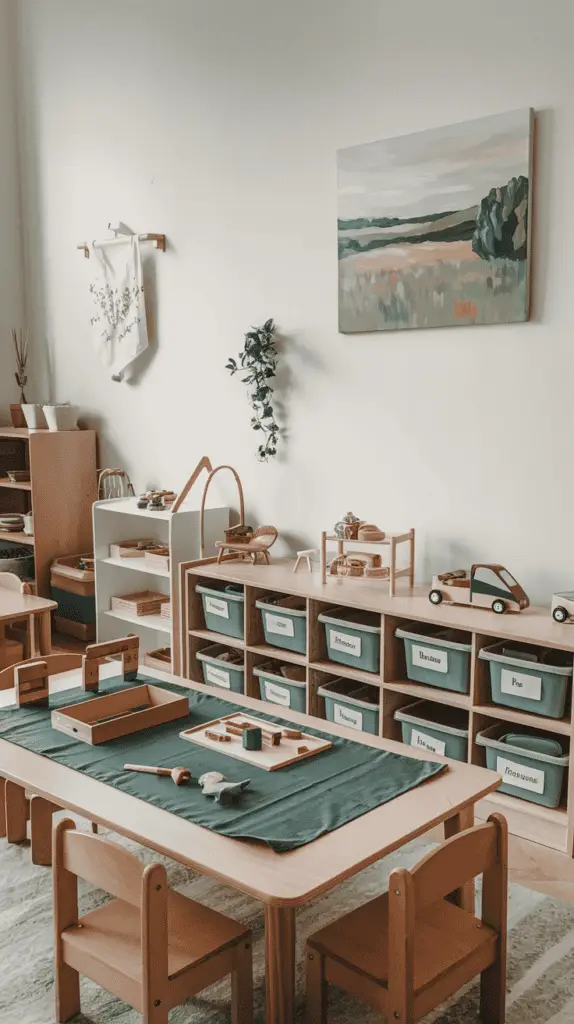
Instead of trying to keep every toy within reach, prioritize a minimalist, structured approach, making the space functional, peaceful, and enjoyable for both children and parents.
Final Thoughts: Why a Montessori Playroom is Perfect for Small Spaces
A small playroom doesn’t have to feel cramped or chaotic—with the right layout, intentional toy selection, and Montessori-inspired organization, even a tiny space can be engaging, structured, and full of learning opportunities.
Key Takeaways:
✔ Use soft, neutral, and pastel colors to create a calm and inviting space.
✔ Incorporate natural materials like wood, woven baskets, and linen textiles.
✔ Set up child-friendly shelves to encourage independence in choosing activities.
✔ Rotate toys regularly to keep engagement high without clutter.
✔ Create defined play zones for reading, sensory play, and practical life skills.
✔ Choose multi-functional furniture to maximize space and adaptability.
✔ Encourage order and responsibility with simple storage solutions and clean-up routines.
By following these principles, your small Montessori playroom will become a space where creativity, learning, and independence thrive—proving that even the smallest room can spark big imagination.
Next Steps
Are you ready to transform your child’s small playroom into a Montessori-inspired space? Start by choosing a color palette, setting up open shelving, and introducing natural elements to create a calm, organized, and engaging environment.
